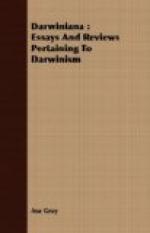I-10. Quadrupeds of America,” vol. ii., p. 239.
I-11. “Proceedings of the American Academy of Arts and Sciences,” vol. iv., p. 178.
I-12. Owen adds a third, viz., vegetative repetition; but this, in the vegetable kingdom, is simply unity of type.
I-13. “Contributions to Natural History of America,” vol. i., pp. 127—131.
I-14. Op. cit., p. 130.
II-1. To parry an adversary’s thrust at a vulnerable part, or to show that it need not be fatal, is an incomplete defense. If the discussion had gone on, it might, perhaps, have been made to appear that the Darwinian hypothesis, so far from involving the idea of necessity (except in the sense that everything is of necessity), was based upon the opposite idea, that of contingency.
III-1. Vide “Proceedings of the British Association for the Advancement of Science,” 1859, and London Athenoeum, passim. It appears to be conceded that these “celts” or stone knives are artificial productions, and apparently of the age of the mammoth, the fossil rhinoceros, etc.
III-2. See “Correspondence of M. Nickles,” in American Journal of Science and Arts, for March, 1860.
III-3. See Morlot, “Some General Views on Archaeology,” in American Journal of Science and Arts, for January, 186o, translated from “Bulletin de la Societe Vaudoise,” 1859.
III-4. Page 484, English edition. In the new American edition (vide Supplement, pp. 431, 432) the principal analogies which suggest the extreme view are referred to, and the remark is appended: “But this inference is chiefly grounded on analogy, and it is immaterial whether or not it be accepted. The case is different with the members of each great class, as the Vertebrata or Articulata; for here we have in the laws of homology, embryology, etc., some distinct evidence that all have descended from a single primordial parent.”
III-5. In Bibliotheque Universelle de Geneve, March, 1860.
III-6. This we learn from his very interesting article, “De la Question de l’Homme Fossile,” in the same (March) number of the Biblioteque Universelle. (See, also, the same author’s “Note sur la Periode Quaternaire ou Diluvienne, consideree dans ses Rapports avec l’Epoque Actuelle,” in the number for August, 1860, of the same periodical.)
III-7. In Comptes Rendus, Academie des Sciences, February 2, 1857.
III-8. Whatever it may be, it is not “the homoeopathic form of the transmutative hypothesis,” as Darwin’s is said to be (p. 252, American reprint), so happily that the prescription is repeated in the second (p. 259) and third (p. 271) dilutions, no doubt, on Hahnemann’s famous principle, of an increase of potency at each dilution. Probably the supposed transmutation is per saltus. “Homoeopathic doses of transmutation,” indeed! Well, if we really must swallow transmutation in some form or other, as this reviewer intimates, we might prefer the mild homoeopathic doses of Darwin’s formula to the allopathic bolus which the Edinburgh general practitioner appears to be compounding.




